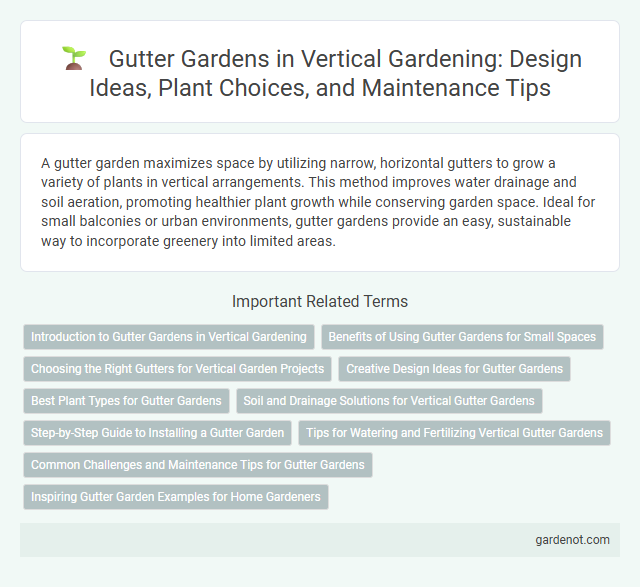A gutter garden maximizes space by utilizing narrow, horizontal gutters to grow a variety of plants in vertical arrangements. This method improves water drainage and soil aeration, promoting healthier plant growth while conserving garden space. Ideal for small balconies or urban environments, gutter gardens provide an easy, sustainable way to incorporate greenery into limited areas.
Introduction to Gutter Gardens in Vertical Gardening
Gutter gardens maximize vertical gardening space by utilizing recycled rain gutters as planting beds, ideal for urban environments with limited ground area. These modular systems support various crops like herbs, succulents, and leafy greens, promoting efficient water drainage and root aeration. Integrating gutter gardens into walls or fences enhances greenery while conserving soil and reducing maintenance efforts.
Benefits of Using Gutter Gardens for Small Spaces
Gutter gardens maximize vertical space by utilizing narrow, often unused areas, making them ideal for small balconies, patios, or urban environments. They improve air quality and provide fresh herbs or vegetables, enhancing both health and sustainability. These lightweight, modular systems require minimal soil and water, reducing maintenance while promoting efficient resource use.
Choosing the Right Gutters for Vertical Garden Projects
Selecting the right gutters for vertical garden projects is crucial for optimal plant growth and water management. Aluminum gutters offer durability and rust resistance, while PVC gutters provide lightweight and cost-effective options ideal for smaller installations. Proper gutter size and shape ensure efficient drainage and support healthy root systems in vertical garden setups.
Creative Design Ideas for Gutter Gardens
Gutter gardens transform narrow, unused gutters into thriving vertical green spaces by creatively stacking or layering multiple gutters for a tiered effect. Innovative designs incorporate colorful flowering plants, succulents, or herbs, maximizing limited space while enhancing aesthetic appeal. Integrating drip irrigation systems ensures efficient watering, promoting healthy growth and sustainability in even the smallest urban settings.
Best Plant Types for Gutter Gardens
Ideal plants for gutter gardens include shallow-rooted herbs like thyme, mint, and chives, which thrive in limited soil depth while providing aromatic benefits. Succulents such as sedum and hens-and-chicks are excellent choices due to their drought tolerance and minimal maintenance requirements. Small flowering plants like pansies and violas add vibrant color and adapt well to the confined spaces of gutter garden systems.
Soil and Drainage Solutions for Vertical Gutter Gardens
Vertical gutter gardens require well-draining soil mixes composed of lightweight, organic materials such as coconut coir, perlite, and vermiculite to maintain moisture balance without waterlogging. Proper drainage is achieved by incorporating a mesh lining or small holes at the base of each gutter section, allowing excess water to flow out and prevent root rot. Effective soil and drainage solutions promote healthy root development and overall plant vitality in vertical gutter garden systems.
Step-by-Step Guide to Installing a Gutter Garden
Installing a gutter garden begins by selecting sturdy, clean gutters and mounting them securely on a wall or fence with brackets or hooks, ensuring proper spacing for plant growth. Next, drill drainage holes at the bottom of the gutters to prevent waterlogging and fill them with a lightweight, nutrient-rich soil mix suitable for the chosen plants. Finally, arrange low-maintenance, shade-tolerant plants like succulents or herbs in the gutters, water them regularly, and monitor for adequate sunlight to encourage healthy vertical garden growth.
Tips for Watering and Fertilizing Vertical Gutter Gardens
Water vertical gutter gardens consistently to prevent soil drying, using a drip irrigation system to provide even moisture distribution. Select a balanced, water-soluble fertilizer applied every 4-6 weeks to promote healthy plant growth without over-fertilizing. Monitor drainage closely to avoid waterlogging, ensuring gutters have adequate holes to allow excess water to escape and maintain root health.
Common Challenges and Maintenance Tips for Gutter Gardens
Gutter gardens often face challenges such as limited soil depth leading to poor root development and water retention issues that can cause drought stress or root rot. Regular maintenance includes ensuring proper drainage by cleaning debris from gutters, monitoring soil moisture levels to balance watering, and selecting drought-resistant plants suited for shallow soil environments. Periodic fertilization with balanced nutrients supports healthy growth and helps mitigate nutrient deficiencies common in confined spaces.
Inspiring Gutter Garden Examples for Home Gardeners
Gutter gardens offer a creative vertical gardening solution using repurposed rain gutters mounted on walls or fences, maximizing limited space for home gardeners. Popular examples include cascading herb corridors and vibrant flower strips that optimize drainage and sunlight exposure. These setups demonstrate efficient water management and versatility, inspiring eco-friendly urban gardening with minimal maintenance requirements.
Gutter garden Infographic

 gardenot.com
gardenot.com